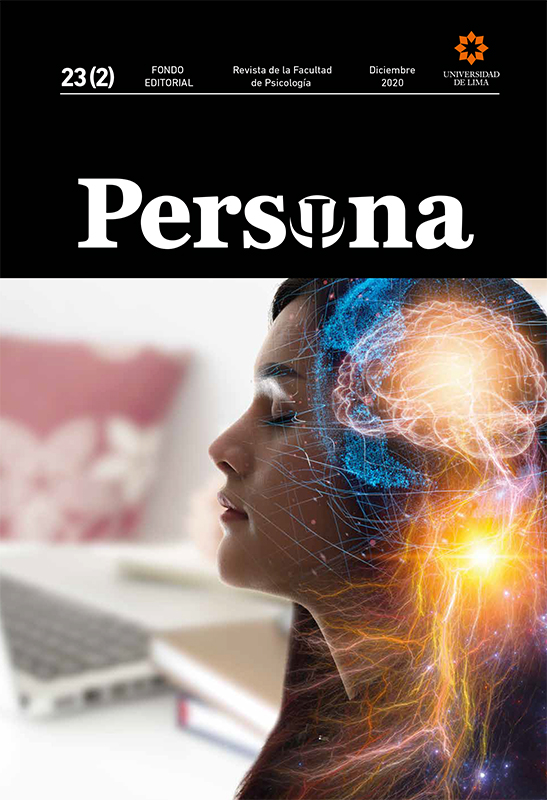Propiedades psicométricas de la Escala de Ansiedad Social de Liebowitz en estudiantes universitarios peruanos
DOI:
https://doi.org/10.26439/persona2020.n023(2).4903Palabras clave:
Trastorno de ansiedad social, Escala de Ansiedad social de Liebowitz, propiedades psicométricas, análisis factorial, confiabilidadResumen
El objetivo del estudio fue analizar las propiedades psicométricas de la Escala de Ansiedad Social de Liebowitz (LSAS), por lo que se evaluó su estructura factorial y su consistencia interna. El estudio estuvo conformado por una muestra de 549 estudiantes de una universidad pública peruana. En el análisis factorial confirmatorio se comparó soluciones de dos, tres, cuatro, cinco y seis factores, evidenciando un mejor ajuste en el modelo de cinco dimensiones propuesto por Caballo, Salazar, Arias, Hofmann & Curtis (2019), χ² = 319.43, CFI = .991, RMSEA = .043, TLI = .990, SRMR = .051. Asimismo, se analizó la consistencia interna de los cinco factores empleando el coeficiente omega encontrando valores entre .81 a .62. En conclusión, la LSAS mostró adecuadas propiedades psicométricas en cuanto a los procedimientos evaluados y los resultados se encuentran a favor de una estructura de 5 factores.
Descargas
Referencias
Alonso, J., Angermeyer, M. C., Bernert, S., Bruffaerts, R., Brugha, T. S., Bryson H., ...Vollebergh, W. A. (2004). Disability and quality of life impact of mental disorders in Europe: results from the European Study of the Epidemiology of Mental Disorders (ESEMeD) project. Acta Psychiatrica Scandinavica Supplementum, 109(420), 38-46. https://doi.org/10.1111/j.1600-0047.2004.00325.x
American Psychiatric Association. (2013). Diagnostic and Statistical Manual of Mental Disorders (DSM-5). Washington D. C.: Autor.
Baker, S. L., Heinrichs, N., Kim, H. J., y Hofmann, S. G. (2002). The Liebowitz Social Anxiety Scale as a self-report instrument: a preliminary psychometric analysis. Behavior Research and Therapy, 40(6), 701-715. https://doi.org/10.1016/s0005-7967(01)00060-2
Bandelow, B., y Michaelis, S. (2015). Epidemiology of anxiety disorders in the 21st century. Dialogues in Clinical Neuroscience, 17(3), 327-335. Recuperado de https://www.dialogues-cns.org/contents-17-3/dialoguesclinneurosci-17-327/
Bobes, J., Badía, X., L. A., García, M., González, M. P., y Dal-Ré, R. (1999). Validación de las versiones en español de los cuestionarios Liebowitz Social Anxiety Scale, Social Anxiety and Distres Scale y Sheehan Disability Inventory para la evaluación de la fobia social. Medicina Clínica, 112(14), 530-538. Recuperado de https://www.unioviedo.es/psiquiatria/wp-content/uploads/2017/03/1999_Bobes_Validacion_MedClinicaBCN.pdf
Bruce S. E., Yonkers, K. A., Otto, M. W., Eisen, J. L., Weisberg, R. B., Pagano, M. ... Keller M. B. (2005). Influence of psychiatric comorbidity on recovery and recurrence in generalized anxiety disorder, social phobia, and panic disorder: a 12-year prospective study. The American Journal of Psychiatry, 162(6), 1179-1187. https://doi.org/10.1176/appi.ajp.162.6.1179
Caballo, V. E., Salazar, I. C., Arias, V., Hofmann, S. G., y Curtiss, J. (2019). Psychometric properties of the Liebowitz Social Anxiety Scale in a large cross-cultural Spanish and Portuguese speaking sample. Brazilian Journal of Psychiatry, 41(2), 122-130. https://doi.org/10.1590/1516-4446-2018-0006
Caballo, V. E., Salazar, I. C., Irurtia M. J., Arias, B., y Nobre-Sandoval, L. (2013). The assessment of social anxiety through five self-report measures, LSAS-SR, SPAI, SPIN, SPS, and SIAS: a critical analysis of their factor structure. Behavioral Psychology, 21, 423-448. Recuperado de https://www.behavioralpsycho.com/wp-content/uploads/2019/08/01.Caballo_21-3oa.pdf
Caballo, V. E., Salazar, I. C., Irurtia, M. J., Olivares, P., y Olivares, J. (2014). Relación de las habilidades sociales con la ansiedad social y los estilos/trastornos de la personalidad. Behavioral Psychology, 22(3), 401-422. Recuperado de https://www.behavioralpsycho.com/producto/relacion-de-las-habilidades-sociales-con-la-ansiedad-social-y-los-estilos-trastornos-de-la-personalidad/
Connor, K. M., Davidson, J. R., Churchill, L. E., Sherwood, A., Foa, E., ... Wisler, R. H. (2000). Psychometric properties of the Social Phobia Inventory (SPIN). New self-rating scale. British Journal of Psychiatry: The Journal of Mental Science, 176, 379-386. https://doi.org/10.1192/bjp.176.4.379
De Beurs, E., Tielen, D., y Wollmann, L. (2014). The Dutch Social Interaction Anxiety Scale and the Social Phobia Scale: reliability, validity, and clinical utility. Psychiatry Journal, 2014, 360193. https://doi.org/10.1155/2014/360193
Filho, A. S., Hetem, L. A. B., Ferrari, M. C. F., Trzesniak, C., Martín-Santos, R., Borduqui, T., ... Crippa, J. A. (2010). Social anxiety disorder: what are we losing with the current diagnostic criteria? Acta Psychiatrica Scandinava, 121(3), 216-226. https://doi.org/10.1111/j.1600-0447.2009.01459.x
Franco-Jimenez, R. A., y Pérez, C. (2018). Adaptación y validación de la Escala de Ansiedad Social de Liebowitz en muestra clínica de un hospital estatal (tesis de pregrado). Universidad Ricardo Palma, Lima.
Fresco, D. M., Coles, M. E., Heimberg, R. G., Liebowitz, M. R., Hami, S., ... Goetz, D. (2001). The Liebowitz Social Anxiety Scale: a comparison of the psychometric properties of self-report and clinician administered formats. Psychological Medicine, 31(6), 1025-1036. https://doi.org/10.1017/s0033291701004056
González, M. P., Bobes, J., García, M., Badía, X., Luque, A., y Dal-Ré, R. (1998). Assessing social phobia. The Spanish validation of the “gold standard” clinical scales: the LSAS and the SADS. European Neuropsychopharmacology, 8, S259-S260. https://doi.org/10.1016/s0924-977x(98)80471-9
Guo, X., Meng, Z., Huang, G., Fan, J., Zhou, W., Ling, W., ... Su, L. (2016). Meta-analysis of the prevalence of anxiety disorders in mainland China from 2000 to 2015. Scientific Reports, 6, 28033. https://doi.org/10.1038/srep28033
Heimberg, R. G., y Holaway, R. M. (2007). Examination of the know-groups validity of the Liebowitz Social Anxiety Scale. Depression and Anxiety, 454(6), 447-454. https://doi.org/10.1002/da.20277
Heimberg, R. G., Horner, K. J., Juster, H. R., Safren, S. A., Brown, E. J., Schneier, F. R.,... Liebowitz, M. R. (1999). Psychometric properties of the Liebowitz Social Anxiety Scale. Psychological Medicine, 29(1), 199-212. https://doi.org/10.1017/s0033291798007879
Heimberg, R. G., Mueller, G. P., Holt, C. S., Hope, D. A., y Liebowitz, M. R. (1992). Assessment of anxiety in social interaction and being observed by others: the Social Interaction Anxiety Scale and the Social Phobia Scale. Behavior Therapy, 23(1), 53-73. https://doi.org/10.1016/S0005-7894(05)80308-9
Hofmann, S. G., Asnaani, M. A., y Hinton, D. E. (2010). Cultural aspects in social anxiety and social anxiety disorder. Depression and Anxiety, 27(12), 1117-1127. https://doi.org/10.1002/da.20759
Hu, L.-t., y Bentler, P. M. (1999). Cutoff criteria for fit indexes in covariance structure analysis: conventional criteria versus new alternatives. Structural Equation Modeling, 6(1), 1-55. https://doi.org/10.1080/10705519909540118
Kerlinger, F. N., y Lee, H. B. (2002). Investigación del comportamiento: métodos de investigación en ciencias sociales. Ciudad de México: McGraw-Hill.
Levin, J. B., Marom, S., Gur, S., Wechter, D., y Hermesh, H. (2002). Psychometric properties and three proposed subscales of a self-report version of the Liebowitz Social Anxiety Scale translated into Hebrew. Depression and Anxiety, 16(4), 143-151. https://doi.org/10.1002/da.10064
Liebowitz, M. R. (1987). Social phobia. Modern Problems in Pharmacopsychiatry, 22, 141-173. https://doi.org/10.1159/000414022
Maldonado, L., Huang, Y., Chen, R., Kasen, S., Cohen, P., y Chen, H. (2013). Impact of early adolescent anxiety disorders on self-esteem development from adolescence to young adulthood. The Journal of Adolescent Health: Official Publication of the Society for Adolescent Medicine, 53(2), 287-292. https://doi.org/10.1016/j.jadohealth.2013.02.025
McDonald, R. P. (1999). Test theory: a unified treatment. Mahwah, NJ: Lawrence Erlbaum Associates, Inc.
Mehmetoglu, M., y Jakobsen, T. G. (2016). Applied statistics using Stata: a guide for the social sciences. Londres: Sage.
Oakman, J., Van Ameringen, M., Mancini, C., y Farvolden, P. (2002). A confirmatory factor analysis of a self-report version of the Liebowitz Social Anxiety Scale. Journal of Clinical Psychology, 59(1), 149-161. https://doi.org/10.1002/jclp.10124
Ratnani, I. J., Vala, A. U., Panchal, B. N., Tiwari, D. S., Karambelkar, S. S., Sojitra, M. G., y Nagori, N. N. (2017). Association of social anxiety disorder with depression and quality of life among medical undergraduate students. Journal of Family Medicine and Primary Care, 6(2), 243-248. https://doi.org/10.4103/2249-4863.219992
Sado, M., Takechi, S., Inagaki, A., Fujisawa, D., Koreki, A., Mimura, M., y Yoshimura, K. (2013). Cost of anxiety disorders in Japan in 2008: a prevalence-based approach. BMC Psychiatry, 13, 338. https://doi.org/10.1186/1471-244x-13-338
Salazar, I. C., Caballo, V. E., y Arias, B. (2016). Validez de constructo y fiabilidad del “Cuestionario de Ansiedad Social para Adultos” (CASO) en Colombia. Revista Latinoamericana de Psicología, 48(2), 98-107. https://doi.org/10.1016/j.rlp.2015.07.001
Safren, S. A., Heimberg, R. G., Horner, K. J., Juster, H. R., Schneier, F. R., y Liebowitz, M. R. (1999). Factor structure of social fears: the Liebowitz Social Anxiety Scale. Journal of Anxiety Disorders, 13(3), 253-270. https://doi.org/10.1016/s0887-6185(99)00003-1
Stein M. B., Fuetsch, M., Müller, N., Höfler, M., Lieb, R., y Wittchen, H. (2001). Social anxiety disorder and the risk of depression: a prospective community of adolescents and young adults. Archives of General Psychiatry, 58(3), 251-256. https://doi.org/10.1001/archpsyc.58.3.251
Stein, D. J., Kasper, S., Andersen, E. W., Nil, R., y Lader, M. (2004). Escitalopram in the treatment of social anxiety disorder: analysis of efficacy for different clinical subgroups and symptom dimensions. Depression and Anxiety, 20(4), 175-181. https://doi.org/10.1002/da.20043
Stein, D. J., Lim, C., Roest, A. M., De Jonge, P., Aguilar-Gaxiola, S., Al-Hamzawi, A., ... Scott, K. M. (2017). The cross-national epidemiology of social anxiety disorder: data from the World Mental Health Survey Initiative. BMC Medicine, 15(1), 143. https://doi.org/10.1017/9781316336168.002
Sugawara, N., Yasui-Furukori, N., Kaneda, A., Sato, Y., Tsuchimine, S., Fujii, A. ... Kaneko, S. (2012). Factor structure of the Liebowitz Social Anxiety Scale in community-dwelling subjects in Japan. Japanese Society of Psychiatry and Neurology, 66(6), 525-528. https://doi.org/10.1111/j.1440-1819.2012.02381.x
Terra, M. B., Barros, H. M., Stein, A. T., Figueira, I., Athayde, L. D., Gonçalves, M., ... Silveira, D. X. (2006). Consistência interna e estrutura fatorial da versão em português da Escala de Ansiedade Social de Liebowitz entre pacientes alcoolistas. Revista Brasileira de Psiquiatría, 28(4), 265-269. https://doi.org/10.1590/S1516-44462006005000008
Publicado
Número
Sección
Licencia
La aceptación de publicación implica ceder los derechos de impresión y de reproducción por cualquier forma y medio al editor, manteniendo el autor la propiedad intelectual del artículo.











